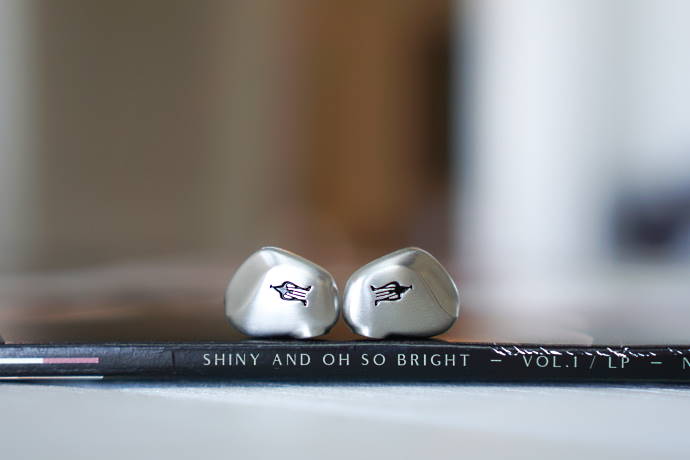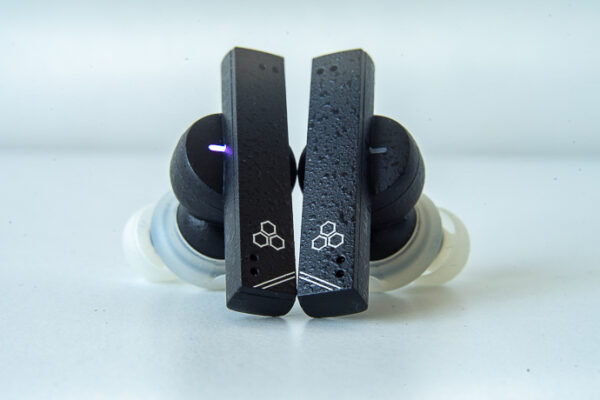Audio characteristics:
So far the Rai Solo is looking like a slam-dunk when it comes to the way they’re packaged and put together, so I was very curious to see if they performed equally-impressively when it came to audio performance.
For some context – I bought myself a pair of 99 Classics a couple of years ago as my go-to portable / closed-back headphones, and I’m continually impressed with their rich, dynamic sound which is also unashamedly “fun” and bass-y. I also have a pair of Meze 12 Classics which I use from time-to-time when travelling, which follow a fairly similar style of tuning to their over-ear counterparts. With this in mind, I had some expectations that the Rai Solo might follow a similar philosophy in terms of delivering a kind of Meze Audio ‘house sound’, particularly given their use of a dynamic driver this time around.

So let’s just say I was genuinely surprised, to say the least when I first listened to the Rai Solo. Its tuning is genuinely unusual – and an unexpected turn from Meze Audio. The most dominant characteristics you’ll notice straight-off-the-bat about the Rai Solo are that it’s vocal forward and treble oriented. There’s a veritable mountain of energy smack-bang in the presence region right around the 5kHz point that dominates the voicing of the Rai Solo, making instruments and percussion around that area in the frequency band particularly accentuated. However, rather than continuing to deliver air and sparkle right up into the highest octave, the Rai Penta’s upper treble rolls-away and is relatively relaxed, leaving detail in the highest octave and air department feeling somewhat distant. An interesting choice.
Meze explained that when developing the Rai Solo they were aiming to create a “fun” but refined, controlled sound signature. They describe the resultant frequency-response as “slightly V-shaped”, but also as “…fun-neutral”. While it’s not always the most useful audio adjective, “fun” usually implies an emphasized bass presentation (especially mid-bass) coupled with some brightness and upper-sparkle. I wouldn’t go so far as calling the Rai Solo bright in the traditional sense however, as the treble ultimately doesn’t deliver a sense of overall air and resolution in the highest octaves. Energetically-forward is perhaps a better descriptor for the Rai Solo, with the in-your-face lower treble energy being delivered in such a fashion that wouldn’t sound unfamiliar to fans of the Grado Labs house sound. Bass is slightly elevated but is fast and tight, and responded well to a +2dB low shelf applied below 80Hz. Depth and layering aren’t the Rai Solo’s strongest points but are par-for-the-course at this price range.
Timbre-wise, the Rai Solo has a slightly metallic, crisp edge to its voicing as a result of a relatively scooped lower mid-range, combined with its signature forwardness. It creates a particularly unique signature, one that’s better experienced than explained.

Listening and comparisons:
That large lower treble peak is either something you like or dislike, depending on your tastes and tolerances. The snare-drum hits in Queen’s ‘Another One Bites the Dust’ are dealt-out with ruthless energy, and Phil Rudd’s loping drumming in AC/DC’s ‘You Shook Me All Night Long’ delivers dagger-like hi-hats and fairly splashy cymbals.
One genre I did genuinely enjoy the Rai Solo with was orchestral music. The Meze delivered all the bustle and tension of John Williams’ ‘Scherzo for Motorcycle and Orchestra’ (from the ‘Indiana Jones and the Last Crusade’ soundtrack) with brilliant detail and drama, the focus on the lower-treble displaying each instrument and section of the orchestra vividly.
What does provide some support to the Rai Solo’s lower treble presentation is a well-extended and dynamic sub-bass. (Now former) Queens of the Stone Age bassist Nick Oliveri’s bass-line in ‘No One Knows’ is delivered with tasty body and impact, while Dave Grohl’s hectic drum-line barrages over the top with harrowing impact.
Keeping things rock-oriented for a moment, ‘Mayonaise’ is probably my favourite track from ‘Siamese Dream’ – The Smashing Pumpkins’ best album (feel free to argue in the comments). Like most Billy Corgan recordings it’s an excessive mess of (awesome) multi-tracked guitars and generally over-the-top 90’s alt-rock. So, I was a little hesitant to unleash this kind of track on the Rai Solos, but it turns out it was actually bloody enjoyable. This kind of music isn’t meant to be played politely, and that’s exactly what the Rai Solos aren’t. However, feed them a hot or overly energetic recording and you might feel the treble section overpowering things. The ‘The Collector’ by Nine Inch Nails was particularly tough-going for me, personally.

In terms of sound stage, things aren’t especially vast but looking at its price, there’s absolutely nothing wrong with it either. The Rai Solo provides a definite in-head experience but in turn offers nice imaging and separation, giving you and the ability to picture individual instruments distinctly placed within a 3D ‘helmet’ just around your head. Henry Rollins’ guest vocal track on Tool’s ‘Bottom’ can sound spookily left-of-stage on some wider-staging IEMs but sounds decisively in-ear with the Rai Penta.
Toning things way back into more subdued listening territory with Nirvana’s excellently-produced ‘MTV Unplugged in New York’ live album, I was expecting an easier-going time, and I have to say I prefer the album listening to the Grado’s GR-10 IEMs. Now, this was an interesting comparison – comparing the Rai Solos with a single BA IEM from a company with a house-sound that’s famously ‘forward’. The Rai Solo and the GR-10 actually have very similar levels of lower-treble energy, but the Grado pulls ahead in terms of resolution and nuance in the upper treble that makes for a more detailed overall presentation. The bass performance is unquestionably more impressive in the Rai Solo, leaving the Grados feeling as if they’ve been accidentally EQ’d down to oblivion by comparison.
Switching over to the Tin Audio T2, the Tins sounds veiled and relaxed – relatively speaking – compared to the Rai Solo. Top-to-bottom the T2 is a more linear, if not ‘safer’ tuning that’s relatively inoffensive by comparison.
As mentioned at the beginning of the review I did happen to have the older, cheaper Meze 12 Classics on-hand, which I was eager to compare back-to-back with their newer, pricier dynamic-driver stable-mate. Using the twin 3.5mm-out of my Chord Mojo to A/B test the Romanian IEM relatives, the Rai Solo proved to have noticeably more powerful sub-bass impact in Radiohead’s ‘Jigsaw Falling into Place’, which is a terrific test-track for transparency – particularly with Jonny Greenwood’s opening acoustic guitar track. Here the more natural, linear delivery and overall non-fatiguing presentation of the Meze 12 is more enjoyable to my ears, but that might say more about me than it does about the Rai Solo.
Click-over to page 3 for source & amp-pairings, and our final verdict.








SiR ReaL
You need to burn these in. That annoying treble peak is gone and the sound is now lush and natural and beautiful.
Matty Graham
Hello mate, glad to hear they’re working out for you. I did play well over 80 hours of music over the Rai Solo before finalising my evaluation, so I can most definitely assure you that was taken into consideration.
Phoenix
I would compare these to Final Audio’s E5000. And there, I’d prefer the FA as it’s just a no-nonsense, long time listening design.
Ferglekutt
I got these recently by doing something I almost never do. I bought them on a whim because I love my 99 Classics, and Meze had a very aggressive Black Friday deal on them. Purchasing something without reading a mountain of reviews isn’t something I often do.
They’re quite comfortable, and because of their (obviously) negligible weight and lack of clamp are easier for me to wear for hours than a full-size headphone. The also have better passive isolation than any full size phone I know of. Their tuning is certainly bright-ish, but they push a good amount of detail at quite low volumes.
On the other hand, dummy that I am, I made assumptions about Meze’s house sound being described well with words like, “rich, mellow, warm,” and so on, so yeah… more fool me. Overall, they put me more in mind of my Grado SR225e than the 99 Classics, and I suppose that’s how I’d recommend them. They’re probably more likely to click with Grado fans than 99 Classics fanciers.
All of this, to me, adds up to something that wouldn’t be my first choice as an all rounder / primary, but I think I’ll use these a lot at work. The good comfort, the very good isolation, and their amenability to low-volume listening (I’ve been enjoying them around what I imagine is the upper-mid 50s (db)) makes them very well suited to the office environment, but anyone who’s ended up here in the comments for this review, as a Rai Solo owner, this review is the most “spot on” one I’ve read.
Jonathan Hall
These Iems really need a long burn in period. At first I truly hated them. So I burned them in for a week and didn’t listen. Upon listening again the Meze house sound was back. Brighter than the classic 99s but Base was back and they opened up a bit as well.
I now really like these and it was not a case of getting used to the sound as I didn’t touch them for a week. I figured give them a change and if they are the same then return them. These are keepers now.